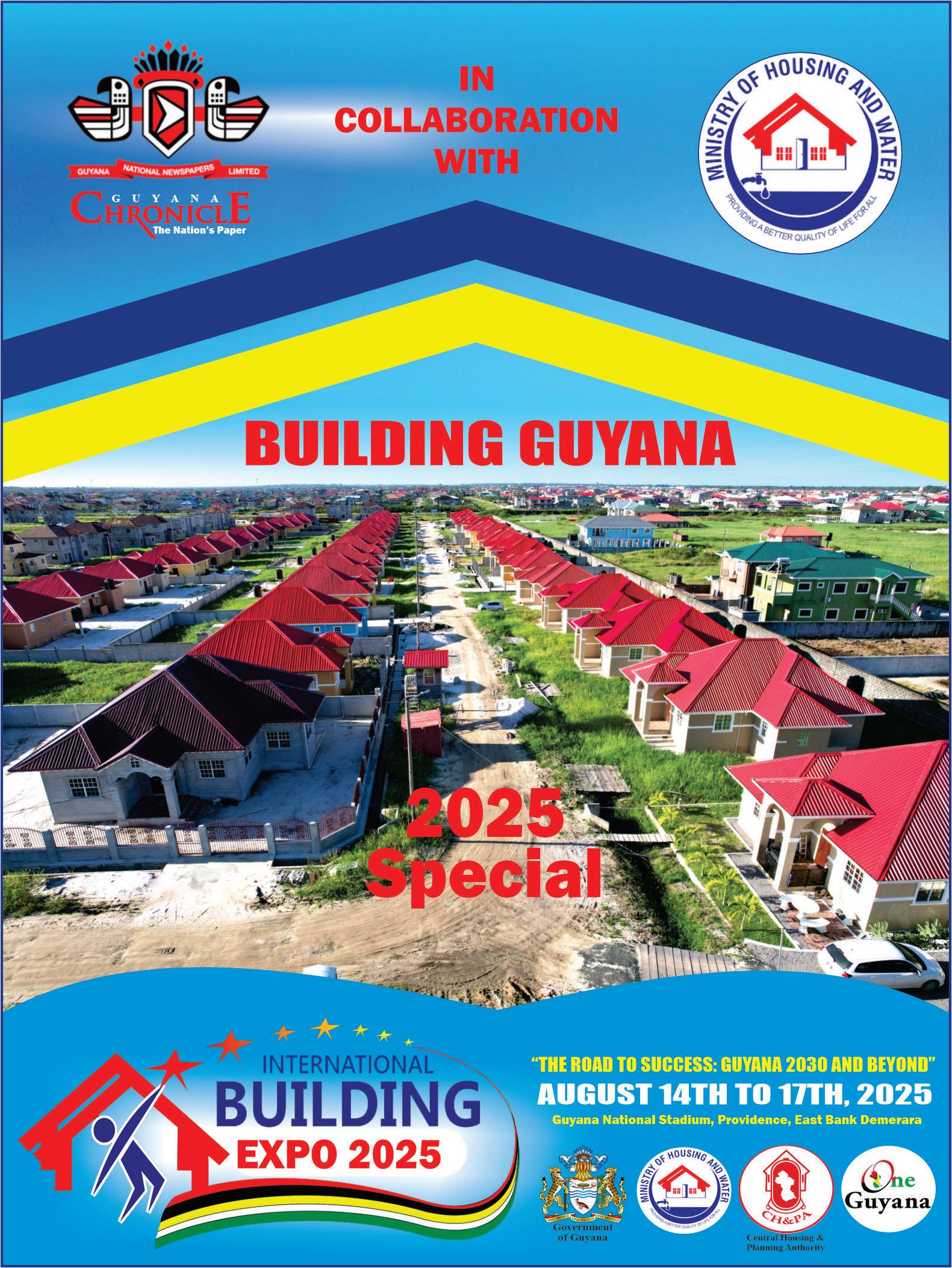

From Blueprints to Biodiversity: Building Expo 2025 opens with transformative vision


The much-anticipated International Building Expo 2025 opens its doors today at the Guyana National Stadium, Providence, promising four days of innovation, networking, and family fun under the theme “The Road to Success, Guyana 2030 and Beyond.”
From August 14 to 17, the stadium grounds will transform into a vibrant hub for the housing and construction sectors, bringing together local and international exhibitors from India, Barbados, the Dominican Republic, Trinidad, and beyond.
Whether you are a prospective homeowner, industry professional, or simply seeking an inspiring day out, this year’s expo promises something for everyone — from cutting-edge building solutions to home improvement ideas, interactive displays, and nightly entertainment.
Minister of Housing and Water, Collin Croal, who recently toured the site, expressed satisfaction with the rapid progress made by organisers despite the challenge of working around ongoing cricket events at the stadium.
He praised the teams that worked
day and night to meet deadlines.
With all the booths already booked, this year’s event has seen unprecedented demand. Minister Croal noted that exhibitors are being encouraged to maintain high presentation standards, ensuring visitors receive maximum value from the experience.
In a nod to Guyana’s recent role as host of a Global Biodiversity Conference, the expo will spotlight environmental sustainability.
Visitors entering the venue will be greeted by displays highlighting the nation’s commitment to biodiversity, as well as large digital screens showcasing Guyana’s evolving landscape and the transformational journey toward Guyana 2030.
A highlight of the event will be the Ministry’s Dream Realised programme, which advances the government’s push for greater homeownership. Between August 15 and 17, more than 2,000 land titles — including those for newly developed East Coast Demerara areas — will be processed and distributed on-site.
Agreements of Sale will also be signed during the



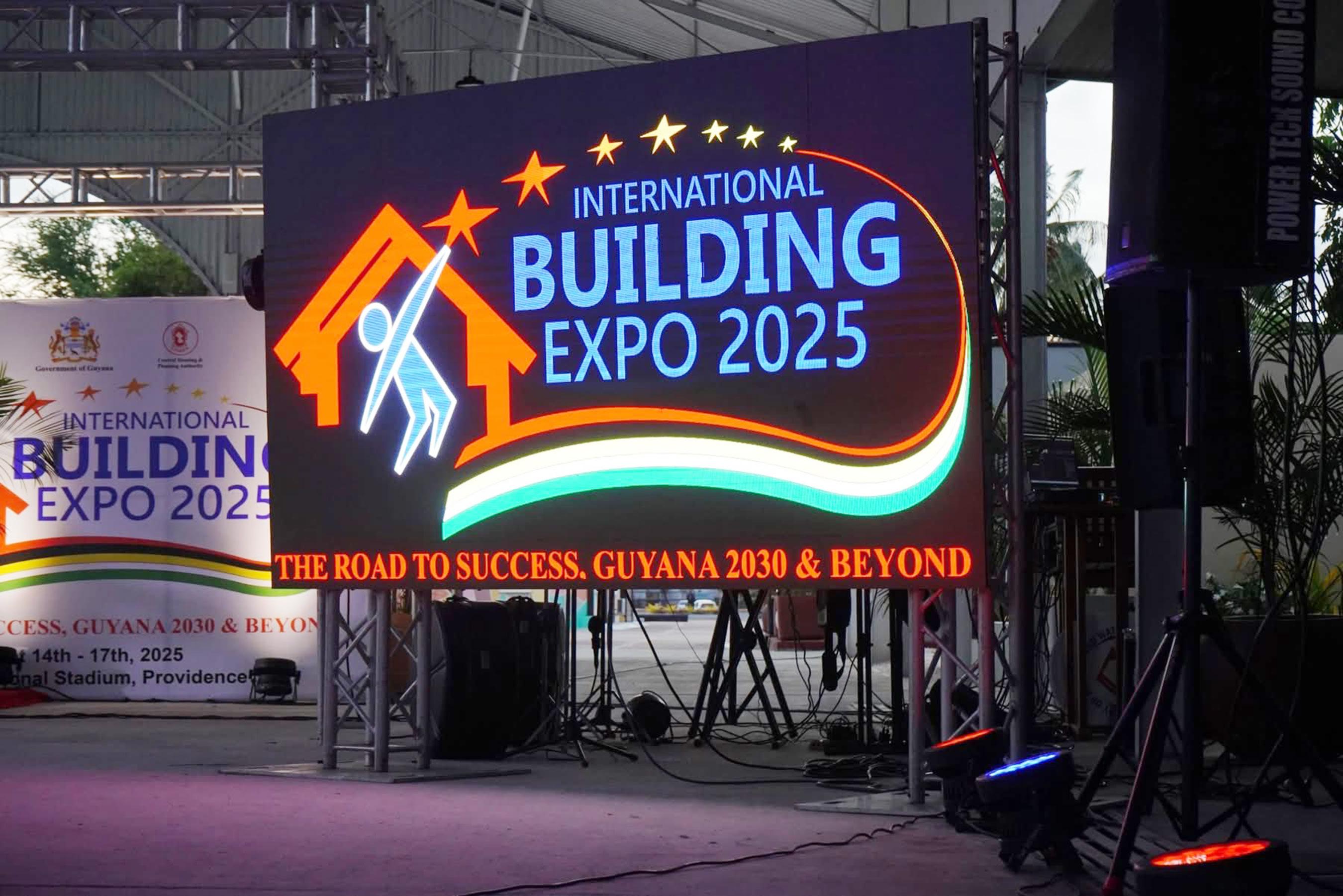
From Blueprints to Biodiversity...
FROM PAGE 2A
expo, moving many allottees closer to realising their dreams of owning a home.
While the expo is a serious networking and business opportunity, organisers have designed it to be family-friendly. The southern side of the venue will host an expanded children’s area alongside food courts, while nightly entertainment from 6:00 PM will feature a different theme each evening. The opening ceremony begins at 5:00 PM today, followed by a formal programme.
Addressing previ-
ous challenges, Minister Croal confirmed upgrades to traffic management and parking arrangements, with more space allocated for vehicles and improved flow to enhance visitor convenience.
Admission Details
• Thursday, August 14 – Free entry from 5:00 PM to 9:00 PM; regular entry fees from 9:01 PM to 11:00 PM.
• Friday to Sunday, August 15–17
– Gates open from 11:00 AM to 11:00 PM. Entry costs $500 for adults and children aged 12 and
over.
Tickets are available at the Ministry of Housing headquarters and all regional housing offices.
From the latest construction technology to live music and hands-on demonstrations, the International Building Expo 2025 is poised to be more than just an exhibition — it’s a showcase of Guyana’s housing vision, an engine for industry collaboration, and a celebration of the nation’s development path toward 2030 and beyond.

Delivering on promise of homeownership
- new beginnings for thousands as housing target surpassed
THE dream of homeownership—once elusive for many Guyanese—is now a reality for tens of thousands of families, as the Government of Guyana officially announced it has surpassed its ambitious target of allocating 50,000 house lots within its first term in office (2020–2025).
The milestone was confirmed during the recent Dream Realised Housing Drive in Region Six, where Minister of Housing and Water, Collin Croal, declared the achievement as a “clear signal” that the government is delivering on its pledges.
“We’ve not only met but surpassed the target we set ourselves,” Minister Croal said. “This is a major milestone for us and a testament to our unwavering com
mitment to the people of Guyana.”
TRANSFORMA-
TIVE ACHIEVEMENTS
From August 2020 to 2025, the Ministry has distributed more than 41,000 residential and commercial house lots, built over 2,000 houses, processed over 14,000 land titles and transports, and completed 31 kilometres of highway infrastructure—laying the groundwork for sustainable, well-planned communities.
Senior Minister in the Office of the President with Responsibility for Finance and the Public Service, Dr. Ashni Singh, linked the current success to a revitalised housing vision after what he described as a period of stagnation between 2015 and 2020.
“The vision was to ensure every Guyanese family had the opportunity to own a home,” Dr. Singh noted. “Since 2020, the sector has undergone an exciting rebirth—driven by stra-




Delivering...
FROM PAGE 6A
tegic planning, significant investment, and a renewed focus on our people’s needs.”
With $78.5 billion spent on the housing sector in 2024 and a record $112.6 billion allocated in Budget 2025, the government plans to push even further, expanding housing access in both coastal and hinterland regions.
LIVES CHANGED FOREVER
Behind the statistics are the stories of real people whose lives have been transformed.
Patrice Sudarsan, a mother, now looks forward to securing a mortgage to build a home for her children: “Now that I have the land, I can go to the bank and build my space for my kids.”
Imelda John, who waited since 2017, said: “Thanks to our President so much… when he come, I receive it. And I’m thankful.”
Tyrell An, an applicant since 2011, called the allocation “a great feeling” and pledged to make full use of his plot.
Gloria Augustus, in the hinterland, expressed joy at finally having a home: “I didn’t have a house, and I thank God I get a nice house and I will try to care it.”
Brenda Welcome described her new home as life-changing after years of moving from place to place: “Now we have our own home… deep down, I know I’m grateful.”
For many, these plots are not just parcels of land—they are symbols of security, independence, and a fresh start. The government’s housing programme has become a movement of national renewal, one that bridges urban and rural divides and brings tangible hope to families across Guyana.
As the nation moves forward, this fulfilled promise stands as a model of what can be achieved when policy, planning, and political will align. With new targets on the horizon, the government is signalling that the journey to building a stronger, more inclusive Guyana is far from over.
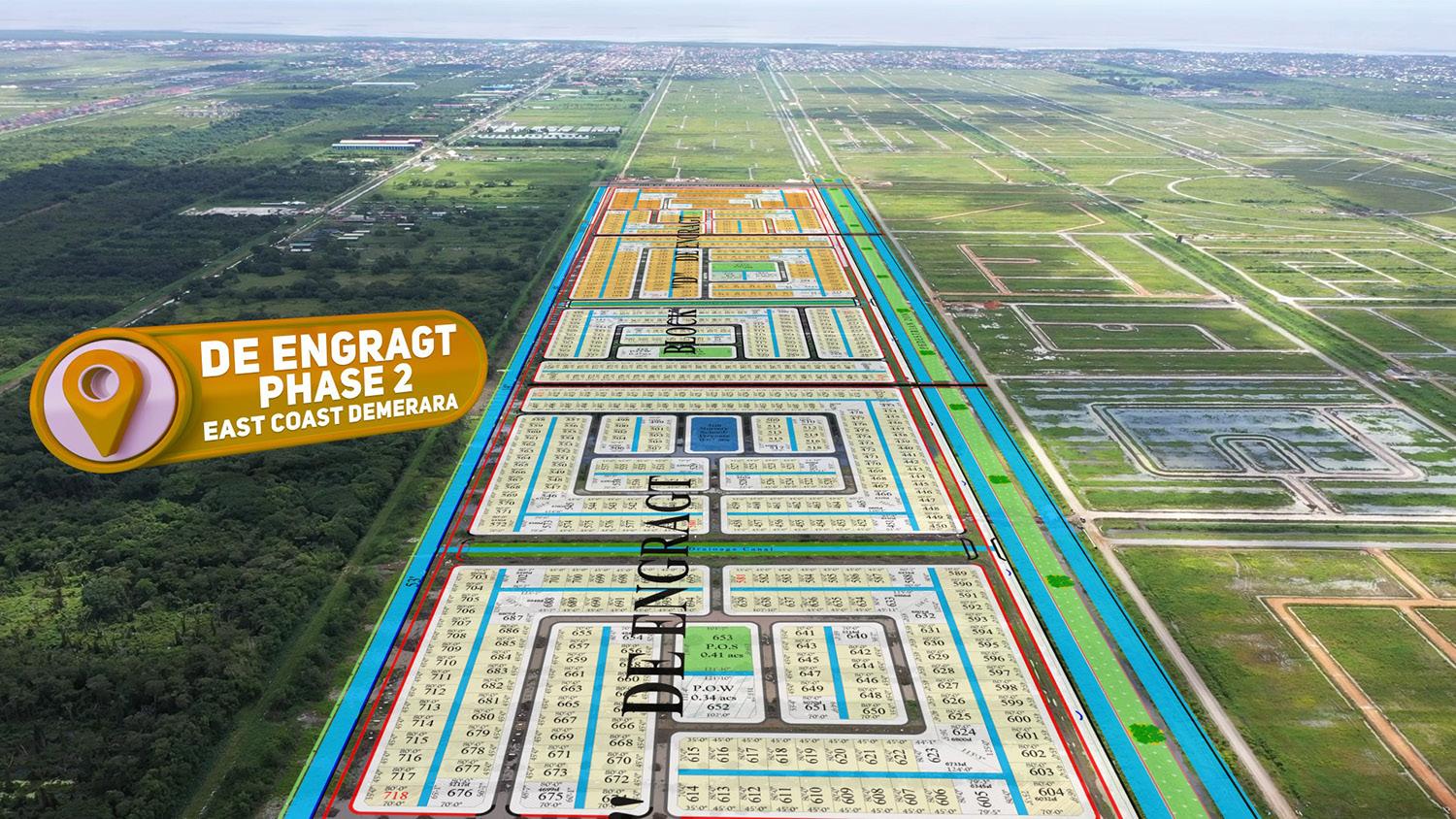
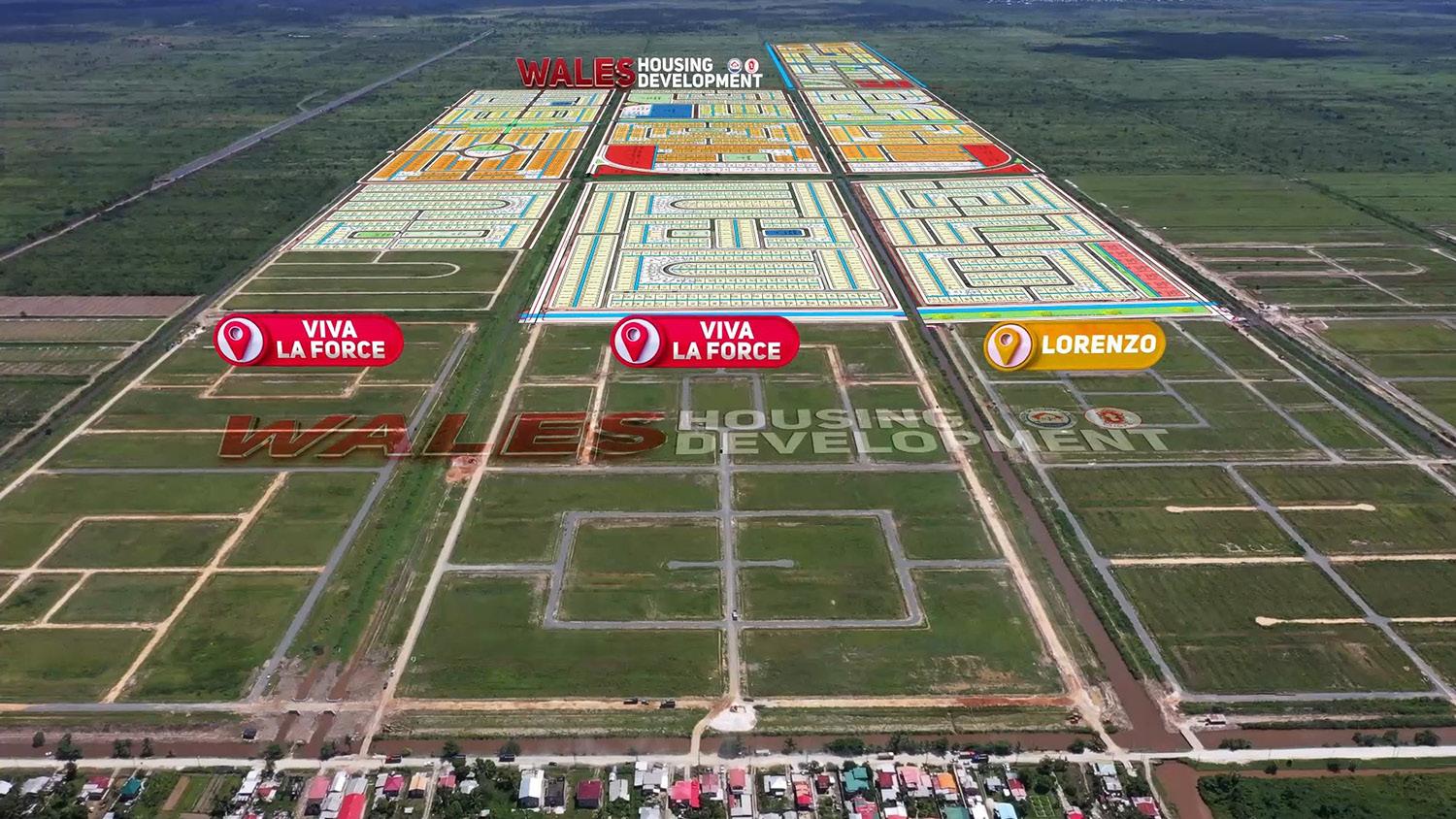

Guyana sees surge in land title processing and distribution since 2020
- Region Four alone accounts for nearly half of Guyana’s land titles in 2024
THE Ministry of Housing and Water conveyance data shows a sharp increase in both the processing and distribution of land titles across Guyana between August 2020 and July 2025.
According to the Ministry’s tables, a total of 21,118 titles were processed during that period, while 12,768 titles were distributed to beneficiaries nationwide.
The year-by-year totals in the Ministry’s dataset reveal the strongest activity occurred in 2024 and the first seven months of 2025.
Titles processed rose from 3,336 in 2023 to 7,193 in 2024, with 6,333 processed in Jan–July 2025 alone, giving a six-year total of 21,118 processed titles.
Titles distributed followed a similar trajectory from 3,178 in 2023 to 3,346 in 2024 and 2,600 in Jan–July 2025 (total dis-
tributed = 12,768) Region-by-region breakdown in the Ministry data shows the largest volumes concentrated in Region Three (Essequibo Islands–West Demerara / surrounds) and Region Four (Demerara-Mahaica / Greater Georgetown corridor).
For example, Region Four recorded 5,274 titles processed in 2024 and Region Three recorded 1,730 processed in Jan–July 2025 — reflecting intensified activity in urban and peri-urban corridors where demand for serviced lots, regularisation and formalisation of tenure has been highest.
Several interior and hinterland regions continue to show much lower activity, reflecting infrastructure and administrative access gaps.
GOVERNMENT LINKS DATA TO LARGE HOUSING PUSH
The Ministry’s numbers come against the backdrop of an ambitious government housing push launched since 2020.
The Administration has repeatedly pledged large-scale lot allocations and titling as central to its housing agenda, citing tens of thousands of house lots distributed nationwide and thousands of titles processed as concrete outcomes of its programme.
The Ministry and state agencies reported that by December 2024 they had processed more than 14,000 land titles and transports, and distributed over 41,000 residential and commercial house lots as part of the multi-year housing drive.
Land titling and the issuance of formal certificates (titles) matter for several reasons. Formal titles secure property rights, open the door to mortgages and formal financing, re-

duce disputes, and encourage investment in property improvements.
Officials have argued that regularisation and title distribution are a precondition for economic mobility for low- and middle-income Guyanese, enabling access to credit and the formal economy. Recent Ministry activity tied titling and agreements of sale events to public outreach
drives such as Building Expo events and targeted regional titling initiatives.
The Ministry’s public engagements this year have included staged titling events and area-specific processing drives. For example, titling exercises in Fitzhope/Conception (Region 10) and community regularisation at Mosquito Hall (River View Mahaica) were
highlighted in Ministry announcements this year, while the Government has said it planned simultaneous signing of agreements of sale and title processing at national events such as the Building Expo. Those events and region-level drives help explain the 2024–2025 uptick in both processed and distributed titles.
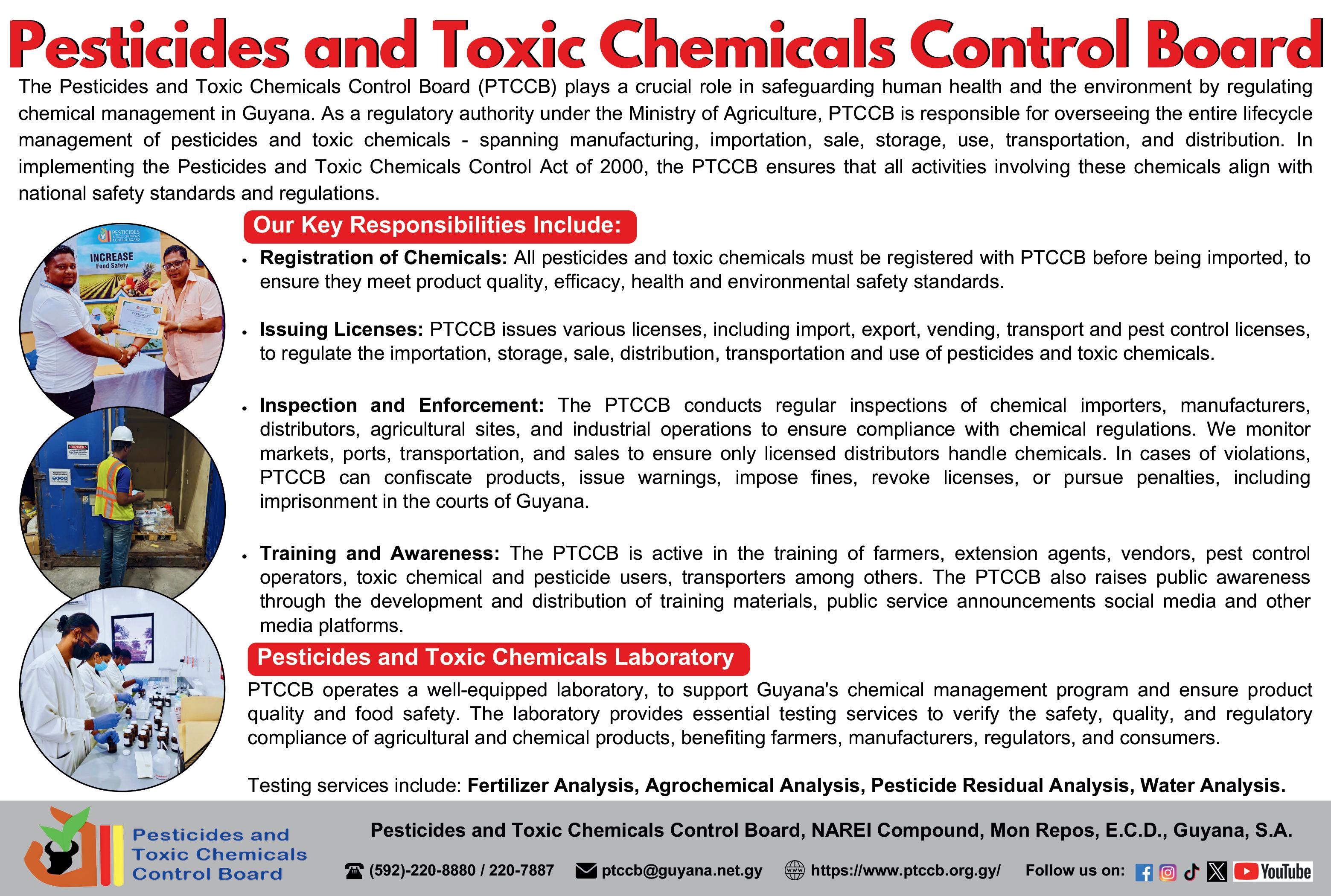

President Ali’s Housing Drive Redefines Guyana’s Development Landscape

Since taking office in August 2020, President Dr Mohamed Irfaan Ali has made housing development one of the cornerstones of his administration’s agenda, not merely as a means of providing shelter, but as a transformative tool for economic empowerment, community building, and national equity.
Over the past four years, the People’s Progressive Party/Civic (PPP/C) government has rolled out an ambitious housing programme aimed at closing Guyana’s housing deficit and creating new pathways to homeownership.
BUILDING MORE THAN HOUSES
From the earliest days of the administration, President Ali signaled that the government’s approach would be about building communities, not just housing schemes. This integrated model includes schools, healthcare facilities, recreational spaces, and commercial hubs — ensuring that residents enjoy not only new homes but also a better quality of life.
The strategy has been bolstered by partnerships with private developers, leveraging public-private collaboration to expand the supply of affordable homes for low- and middle-income families. Projects have embraced modern construction methods — such as pre-fabricated materials and improved design techniques — to
This has involved identifying and preparing large tracts of land, streamlining administrative processes for faster allocations, and investing heavily in supporting infrastructure such as roads, drainage systems, water distribution networks, and electricity supply.
speed up delivery without sacrificing quality.
The 2025 National Budget underscores the scale of the government’s commitment. Finance Minister Dr Ashni Singh allocated $112.6 billion to housing — an increase from $78.5 billion in 2024 — funding: 25,000 additional house lots, 1,000 new homes, 10,000 new land titles, VAT exemptions on building materials, Expanded mortgage ceilings up to $20 million, Restored interest relief ceilings to $30 million, and a single-window system to fast-track homeownership
This follows sustained investment since 2020, which has already seen 40,808 house lots distributed and 20 new housing areas launched across multiple regions by mid-2025. EQUITY AND INCLUSION AT THE CORE
The Ali administration has made equity a guiding principle. Nearly 50 per cent of allocations have gone to single women, 54 per cent to young people aged 21–35, and 90 per cent to low- and middle-income families.
In Region Ten alone, more than $6 billion has been invested in housing infrastructure.
Beyond the coast, hinterland communities have also benefited significantly. Hundreds of families in remote areas now own land and have begun constructing homes — a step that not only provides stability for children and seniors but also anchors economic activity in rural Guyana.
Housing projects under this administration are increasingly aligned with environmental goals. Many new developments incorporate energy-efficient designs, renewable
energy options, and sustainable building materials. This reflects Guyana’s dual mandate to accelerate development while safeguarding its environmental heritage.
LINKING HOUSING TO BROADER TRANSFORMATION
While the national housing programme stands as a flagship policy in its own right, it is also integrated into a wider vision of development. President Ali’s recent investment package for Region One, including a 30 per cent electricity rate reduction, major investments in cocoa and coffee production, and a new cold storage facility for farmers, illustrates this joined-up approach.
By coupling energy affordability, agricultural revitalisation, and community investment with expanded housing access, the adminis -
tration aims to deliver what President Ali calls “real empowerment, real transformation, and real opportunities.”
By the end of 2025, nearly $300 billion will have been invested in housing infrastructure since 2020, making homeownership a tangible reality for tens of thousands of Guyanese families. The result is not only new roofs over people’s heads but thriving communities where children can grow, small businesses can flourish, and families can build secure futures.
As the president often notes, the housing sector’s rapid expansion is about more than meeting targets — it’s about redefining what it means to live and prosper in Guyana, from the bustling coast to the remotest hinterland.
While the national housing programme stands as a flagship policy in its own right, it is also integrated into a wider vision of development
Silica City: A model for climate-resilient urban living
- new young professional flats rising along Soesdyke-Linden Highway
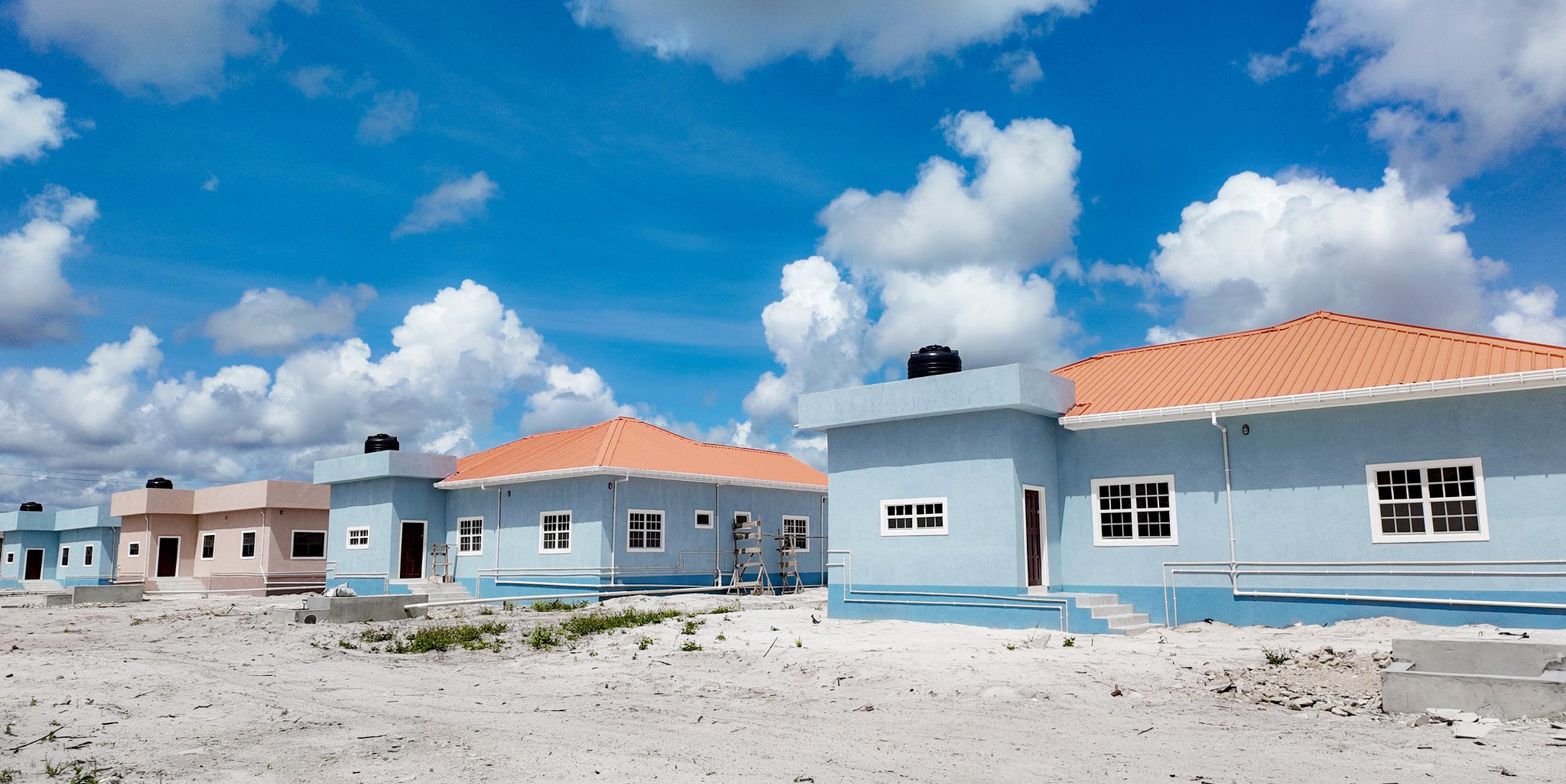

CONSTRUCTION is steadily progressing on the highly anticipated young professional flat housing units at Silica City, a pioneering urban development strategically situated along the Soesdyke-Linden Highway.
Designed with modern living and sustainability in mind, each flat offers a comfortable and functional living space tailored for young professionals and small families.
Each unit features three spacious bedrooms complete with built-in closets, a large kitchen and dining area for communal family living, and a dedicated laundry space — thoughtfully planned to meet contemporary needs.
Residents will not only benefit from well-designed homes but also from the seamless integration of critical infrastructure, as roads, drainage, and electrical networks are concurrently advancing to s upport the growing community.
Silica City itself is a visionary project conceptualized by His Excellency, President Dr. Irfaan Ali. It represents a bold step towards climate-resilient urban development, addressing the challenges posed by climate change and rising sea levels while promoting urban expansion beyond Guyana’s vulnerable coastal areas.
This innovative township will incorporate cut-
ting-edge digital technologies, sustainable infrastructure, and ample green recreational spaces, ensuring a balanced lifestyle that harmonizes growth with environmental stewardship.
The project is meticulously managed by the Planning and Settlement Development Department alongside the Projects Department of the Central Housing and Planning Authority, guaranteeing adherence to quality and forward-thinking urban planning standards.
As Guyana continues to grow economically and demographically, Silica City stands out as a blueprint for future developments—where modern design meets resilience and


sustainability, all while fostering community and improving the quality of life for its residents.
The young profes -
sional flats at Silica City symbolize more than just new homes; they mark a commitment by the Government of Guyana to
create livable, adaptable, and inclusive spaces that respond to today’s environmental realities and tomorrow’s needs.
Hinterland to Coastland: $37.8B Housing investment uplifts families nationwide
In less than five years, Guyana’s housing landscape has been transformed by an unprecedented government investment of approximately $37.8 billion in home construction—turning thousands of house lots into thriving communities and providing families with stability, security, and hope for the future.
Since taking office in August 2020, the government has embarked on an ambitious housing programme designed to make homeownership a reality for low-, moderate-, and middle-income families, young professionals, and vulnerable citizens. According to figures from the Ministry of Housing and Water, 3,876
houses are currently under construction, with 2,134 already completed.
HOMES ACROSS THE NATION
From the East Coast to the hinterland, new developments have sprung up in areas such as Fort Ordnance, Williamsburg/Hampshire, Success, Leonora, Groeneveldt, La Bonne Intention (LBI), Prospect, Diamond, Kuru Kururu (Silica City), Yarrowkabra, and Amelia’s Ward.
One of the most ambitious projects is underway at Palmyra, Region Six, where 100 modern bungalows, each valued at approximately $14 million, are nearing completion. This is just the beginning: nearly 700 homes are planned here
for young professionals, supported by an initial $7 billion infrastructure investment.
In 2024 alone, $4.3 billion was spent on housing along the East Coast corridor to deliver over 550 homes, creating what officials describe as “generational wealth” for the beneficiaries.
The Hinterland Housing Programme is ensuring that even the most remote communities are part of this housing revolution. Over $750 million has been invested so far, delivering 163 completed houses in villages like Kokerite, Warapoka, Tiger Pond, Nappi, and Shiriri.
Another 111 homes are set to benefit vulnerable
families in Regions One, Seven, Eight, and Nine.
Communities such as Imbotero, Arakaka, Baramita, Tassarene, Kangaruma, and Karisparu will soon see new, durable homes— many in areas where formal housing has long been a challenge.
MORE THAN BRICKS AND MORTAR
Minister within the Ministry of Housing and Water, Susan Rodrigues, has emphasised that the programme is not just about shelter, but about building sustainable communities.
Alongside housing units, the government is delivering road networks, drainage, potable water, and street lighting—creating safer, more livable envi -
ronments where businesses can grow and families can thrive.
The administration has also made home construction more affordable through a steel and cement subsidy programme, as well as negotiations with local banks to lower interest rates.
By distributing more than 52,000 house lots— well over its 2020 manifesto target—the government has expanded homeownership opportunities to thousands more families than initially pledged. And the momentum shows no sign of slowing: $112.6 billion has been earmarked for housing initiatives in 2025, promising further growth and modernization.
These housing interventions have generated substantial employment for local contractors, tradespeople, and suppliers. Each construction site becomes a hub of economic activity, feeding back into the national economy while uplifting communities socially and financially.
For many Guyanese families, these initiatives mean more than acquiring a house—they represent the first real chance at a secure, prosperous future. As bulldozers clear land and new roofs rise against the skyline, the government’s housing drive is laying the foundation for a transformed Guyana, one home at a time.










Five-year housing expansion to boost homeownership, community development nationwide - says VP Jagdeo
The People’s Progressive Party Civic (PPP/C) is set to accelerate its national housing programme over the next five years, aiming to build new homes and improve living conditions for thousands of families, Vice President (VP) and General Secretary Dr. Bharrat Jagdeo announced during a recent community outreach on the Essequibo Coast.
Dr. Jagdeo detailed a comprehensive strategy that seeks to make homeownership more accessible, particularly for low-income earners, young couples, and first-time homeowners.
Under the plan, housing applications will be fast-tracked, with direct government support for home construction. Existing communities will also benefit from major upgrades, including concrete drainage systems, enhanced street lighting, recreational spaces, and the installation of security cameras to foster safer neighborhoods.
“Building homes is about more than just structures; it’s about creating secure and vibrant communities
where families can thrive,” Dr. Jagdeo said. He added that improvements in sanitation and waste management, including better garbage collection and disposal systems, are integral to the programme.
The housing expansion is part of a broader initiative to cushion the cost of living. The government plans to continue increasing public sector salaries, raising old-age pensions, enhancing National Insurance Scheme (NIS) benefits, and providing additional public assistance and cash grants to households. Measures will also address utility costs, including affordable electricity, lower cooking gas prices, and stable fuel rates.
To support economic access to housing, Dr. Jagdeo outlined plans to expand local farmers’ markets to reduce food prices and maintain policies that keep interest rates low, making mortgages more affordable.
Residents attending the outreach expressed cautious optimism about the new housing initiatives. Lisa James, a young mother from Affiance, said,
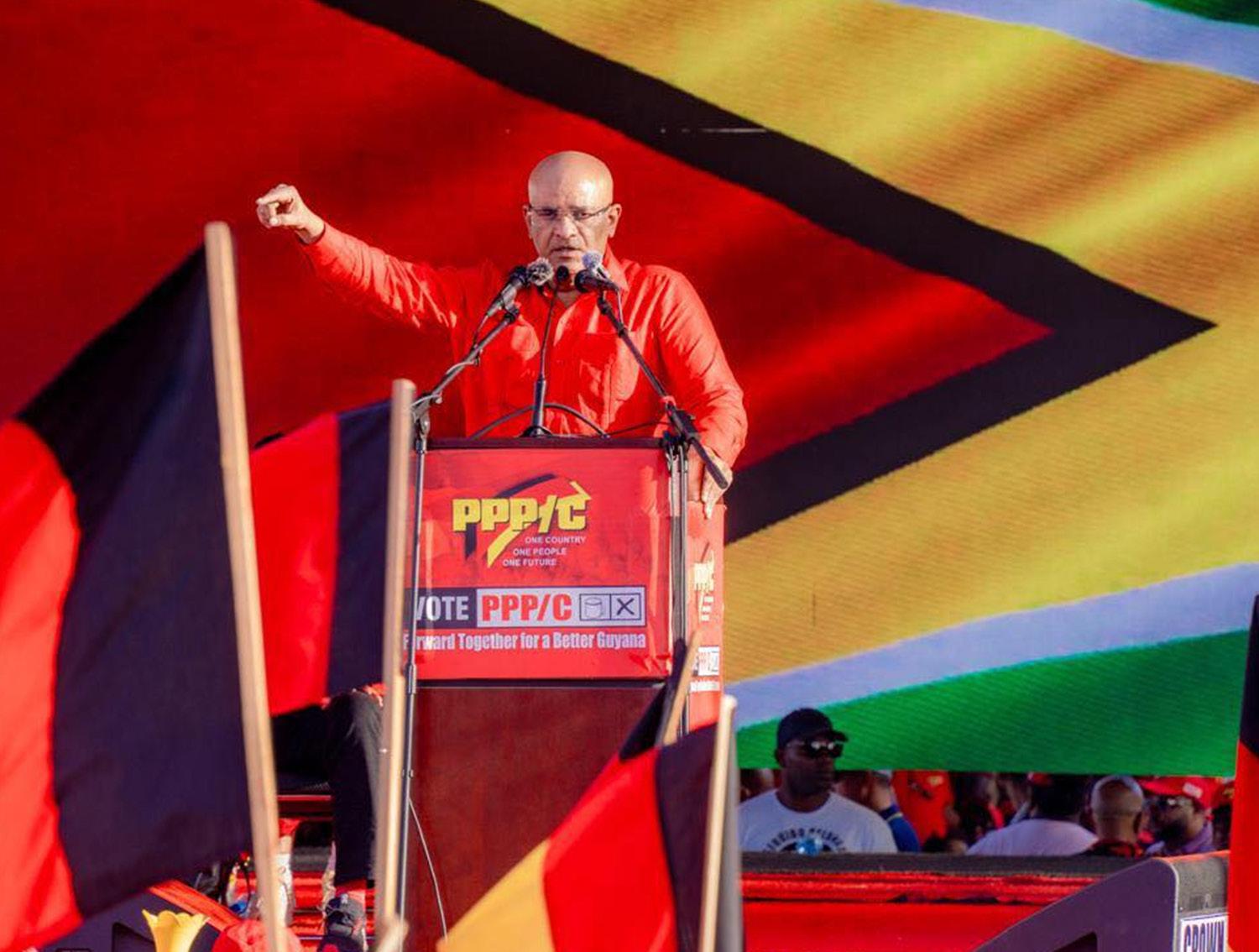
“I’ve been waiting for a house lot for years. If this plan really speeds up the process, it will change my life. I want a better future for my children, and having our own home is a big part of that.”
Part-time worker
Devindra Singh from Zorg-en-Vlygt welcomed the government’s support for the
cost of living. “The cash grants and help with expenses mean a lot, especially with how expensive things have become,” he noted.
Safety and infrastructure improvements were also highlighted as key benefits. Anita Persaud, a teacher from Queenstown, praised the focus on
community security, saying, “Adding more streetlights and security cameras is a great move. It will make our communities feel safer, especially for children and the elderly.”
The outreach concluded with enthusiastic applause, as residents engaged directly with officials to discuss individual concerns and opportunities under the expanded housing programme.
The initiative underscores the PPP/ C’s commitment to addressing Guyana’s housing deficit, enhancing quality of life, and fostering sustainable, inclusive community development across the country.

Vice President and General Secretary Dr. Bharrat Jagdeo during one of his many community outreaches addressed the building of new homes and improve living conditions for thousands of families

Homeownership is more accessible for every Guyanese from 2020-2025
The People’s Progressive Party Civic (PPP/C) government has been persistent in its efforts to ensure every Guyanese citizen has the opportunity to become a homeowner.
The government inherited a backlog of 75,509 housing applications when it took office in August 2020.
However, this figure did not deter the PPP/C administration from carrying out its ambitious housing plan to deliver 50,000 house lots during its first term in office.
Through deliberate policies, the government has exceeded its house lot target in less than five years by delivering over 50,000 house lots to Guyanese from every income bracket, which stands in sharp contrast to just over 7,000 lots that were distributed by the previous administration during its entire tenure in office.
In a single year, the PPP/C government’s houselot allocation surpassed what the previous administration allocated between 2015 to 2020.
According to the statistics from the Ministry of Housing and Water, 47 per cent of house lots allocated were given to women, and 90 per cent went to low-income families.
Speaking at a public rally in Melanie Damishana along the East Coast corridor on recently, Leader of the A Partnership for National Unity (APNU), Aubrey Norton, said, “They said they were going to deliver 50,000 house lots; they failed.” This statement directly contradicts the government’s delivery of over 50,000 lots.
To give Guyanese who lack the financial means to obtain a mortgage access to a house, Norton also suggested a rent-to-own programme without providing any details about how it would translate into home-ownership. The government, on the other hand, has implemented a series of housing programmes to help Guyanese realise their dreams of own-

ing a home, such as low-interest rates at the local banks and providing them with thousands of dollars in steel and cement vouchers.
Under the steel and cement subsidy programme, over 2,000 individuals across the country have received vouchers totalling over $500 million since 2022.
Homebuilders are provided with one sling of cement and the required steel to build the foundation of houses costing $6 million or less.
Those constructing homes valued between $6 million and $25 million are provided with two slings of cement and the necessary steel to complete the foundation.
Another initiative by the government is the Core Home Support initiative that falls under the $5.8 billion Adequate Housing and Urban Accessibility Programme (AHUAP), which targets vulnerable families and provides them with affordable core homes. The
other components of this project are the housing subsidy and construction of community grounds.
According to Norton, the APNU will create a “house repairs programme” that will give low-income individuals
access to resources so they can repair their homes. It should be noted that Vice-President Dr Bharrat
Jagdeo announced the $50 million house improvement programme in July 2023 for residents from Laing Avenue and Yarrow Dam in Georgetown.
This initiative has assisted many homeowners of Laing Avenue in conducting much-needed repairs on their homes, significantly improving their living standards. Eac h recipient is provided with a voucher valued $250,000 and an additional $100,000 to cover labour expenses.
Other initiatives, such as the Hinterland Housing and the Lethem Housing Support Programmes, were developed to ensure hinterland residents also have equitable access to affordable housing.
Since taking office in August 2020, the government has developed housing schemes in every administrative region.
More than $250 billion has been invested to establish 95 new housing schemes countrywide, compared to the three housing areas that were developed between 2015 to 2020
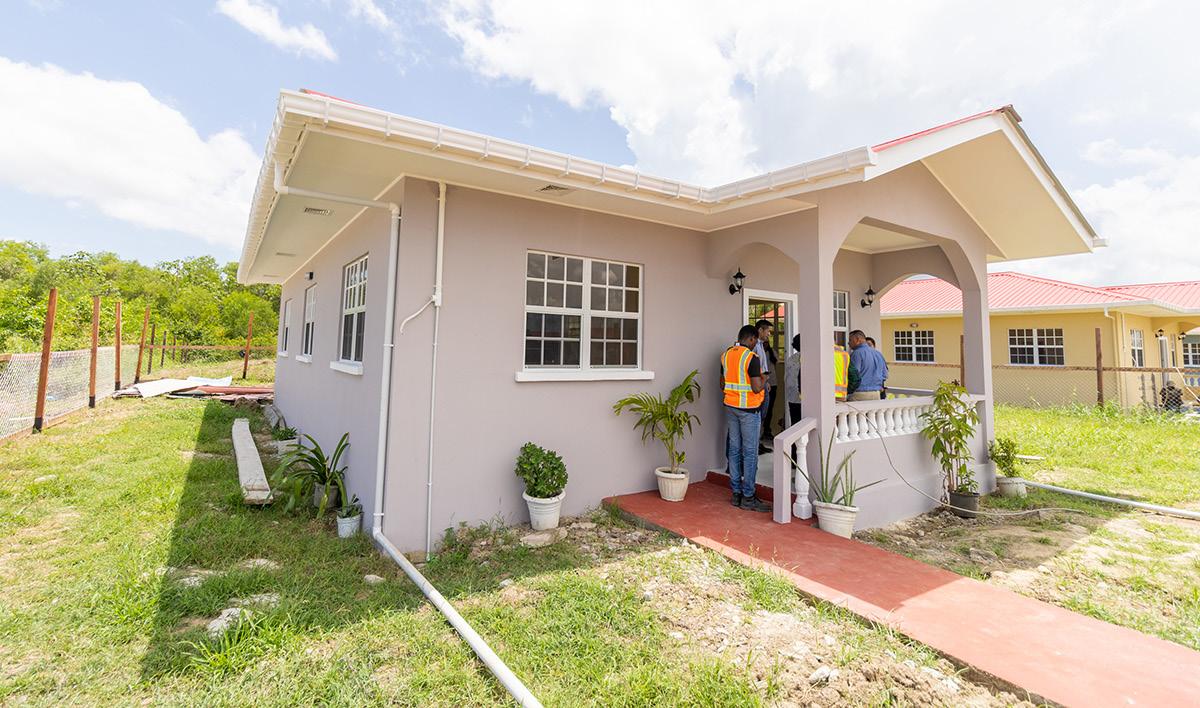
An allottee receiving her house lot from Minister within the Ministry of Housing and Water, Susan Rodrigues
Minister of Housing and Water Collin Croal inspects one of the many houses being constructed in a new housing scheme


Tamika Jeffrey: The face of Guyana’s 50,000th new house lot allocation
FOR Ms. Tamika Jeffrey, the allocation of Parcel 404 in the Tract ‘F1’ Felicity Housing Scheme on July 17, 2025, marked a milestone: not just personal homeownership, but the symbolic 50,000th house lot issued under President Dr. Irfaan Ali’s administration’s housing scheme.
While over 52,000 house lots have been distributed in total, including regularisation efforts, Jeffrey’s award represents a pivotal moment in the roll-out of brand-new housing developments initiated since 2020.
When Jeffrey received the unexpected call notifying her of the allocation, initially she thought it was just an update on her application.
Instead, she learned she had become the programme’s 50,000th beneficiary, a realization that filled her with awe and gratitude.
“I don’t think I can put into words the feeling at that moment,” she shared with the Department of Public Information (DPI).
As an HR Administrative Manager, Jeffrey had patiently waited in line at the Ministry, respecting

the procedure and demonstrating the discipline that ultimately distinguished her in that moment.
HOMEOWNERSHIP: A NEW CHAPTER
Moving from a rental to owning land is more than bricks and mortar, it’s about stability. Jeffrey envi-
sioned a place where her family could gather, a “melting pot” fostering connection and security.
Reflecting on her new beginning, she invoked the words of Dr. Martin Luther King Jr.:
“If you can’t fly, then run. If you can’t run, then walk; if you can’t walk, then crawl,
but whatever you do, keep moving forward.”
For Jeffrey, this lot is more than a plot, it’s the realization of perseverance and hope.
GOVERNMENT’S HOUSING VISION
The significance of Jeffrey’s allotment extends beyond a personal milestone. Since 2020, the Administra-
tion has distributed over 52,000 house lots, combining new developments and efforts to regularize informal settlements.
The 50,000th milestone explicitly highlights the success of new scheme rollouts initiated under President Ali.
Her story reflects the broader achievement of the Ministry of Housing and Water and the Central Housing and Planning Authority (CH&PA), which have delivered land access to thousands of Guyanese families, empowering them through ownership and stability.

Ms. Tamika Jeffrey, the proud recipient of the 50,000th new residential house lot allocated under the national housing programme under the President Irfaan Ali-led administration, is pictured with Minister of Housing and Water, Collin Croal

Thousands benefit from Government’s Steel and Cement Housing Subsidy Programme
THE Government of Guyana’s Steel and Cement Housing Subsidy Programme has emerged as a transformative initiative, assisting thousands of families across all ten administrative regions in constructing their homes.
Launched in 2022 under the leadership of President Dr. Mohamed Irfaan Ali, the programme aims to alleviate the financial challenges faced by low- and middle-income families in the homebuilding process.
To date, over 2,000 vouchers have been distributed nationwide, representing an investment exceeding $500 million in the local construction sector.
Each voucher, valued at $225,000, provides recipients with steel and cement, essential materials for the foundation of homes valued up to $6 million.
For homes estimated between $6 million and
$25 million, beneficiaries receive two slings of cement and the necessary steel.
Minister of Housing and Water, Collin Croal, emphasized that the Steel and Cement Housing Subsidy Programme is a tangible demonstration of the government's commitment to making homeownership accessible.
The initiative complements other housing programmes, such as the removal of VAT on building materials and the expansion of mortgage ceilings, to further support citizens in achieving homeownership.
As the programme continues to expand, the government remains dedicated to ensuring that all Guyanese have the opportunity to own a home, thereby improving their quality of life and contributing to the nation's overall development.


Women account for 47 per cent of house lot allocations
IN a country where access to land has historically been a gateway to economic stability and social progress, Guyana’s latest housing achievement stands as a milestone in equity and empowerment.
The government’s 2020 pledge to distribute 50,000 house lots in its first term has not only been fulfilled but exceeded, reaching over 52,500 allocations when factoring in contributions from the Guyana Lands and Surveys Commission (GLSC).
This accomplishment is not just a matter of numbers; it’s a story about women breaking barriers, low-income families building futures, and a housing sector reshaping the nation’s socio-economic fabric.
WOMEN AT THE FOREFRONT OF CHANGE
For decades, women, particularly single mothers, have faced systemic challenges in securing land and property ownership. But the current housing programme is reversing that trend. An impressive 47 per cent of the allocated house lots have gone to single women, marking a decisive shift in Guyana’s wealth distribution patterns.
This progress builds on earlier achievements: by the close of 2022, nearly 8,000 lots (44 per cent) had been allocated to women individually, with another 28 per cent awarded jointly with partners. Such targeted policymaking is helping to bridge historic gender gaps in land ownership, a factor rec-

ognised globally. In fact, Guyana’s Global Gender Gap ranking has jumped to 35th place—an 18-spot improvement in just one year, according to the World Economic Forum.
“Land ownership is not just about shelter—it’s about security, dignity, and opportunity,” one East Coast Demerara beneficiary said. “Now, I can build for my children without fearing displacement.”
HOUSING
WITH A HUMAN FOCUS: PRIORITISING THE VULNERABLE
The programme’s reach extends beyond gender equity. Ninety per-cent of all lots have been earmarked for low-income families, a deliberate move to ensure that the housing boom does not exclude those most in need. By 2023, more than 28,000 lots had been allocated across low, moderate, and middle-income categories, supplemented by subsidies and mortgage relief to make homeownership more accessible. The results are tangible—families once locked in cycles of high rent and unsta-
ble tenancy are now planning for generational stability.
Minister within the Ministry of Housing and Water, Susan Rodrigues, speaking at the launch of Building Expo 2025, emphasised that the vision goes beyond hitting targets:
“We have accomplished the target we set ourselves… especially for women. This is about empowering people to build, to own, and to thrive.”
Her colleague, Minister Collin Croal, echoed this sentiment, highlighting that the government is not just handing over plots of land. Since 2020, 95 new housing schemes have been developed, complete with paved roads, modern drainage, potable water, and street lighting. “We are creating environments where children can play safely, businesses can grow, and families can plan their futures with confidence,” he said.
The implications of this housing transformation are profound: Economic empowerment for women – Owning property strengthens financial
portunities for upward mobility; and Progressive governance – The balanced, inclusive distribution reflects a government actively delivering on its social commitments.
LOOKING TOWARD 2030 AND BEYOND
independence, opening doors to credit, entrepreneurship, and stability; Improved living standards – Low-income families gain safer housing, better infrastructure, and op-
The housing strategy is part of a larger vision: developing smart, sustainable communities that integrate renewable energy, climate-resilient design, and digital infrastructure. Silica City, the flagship development along the Soesdyke-Linden Highway, will be a model of eco-friendly urban planning.
This future-focused ambition will be showcased at Building Expo 2025—under the theme “The Road to Success: Guyana 2030 and Beyond”, where 373 booths, including a 3D model of Silica City, will give the public a glimpse into Guyana’s next chapter of urban development.
In essence, Guyana’s housing drive is more than a policy, it is a people-powered movement. By placing women and low-income families at the heart of its strategy, the government is not just building homes; it is building security, equality, and hope for generations to come.

New housing scheme planned for Port Kaituma as Gov’t advances national housing drive
THE Ministry of Housing and Water is moving to expand its national housing programme into Guyana’s northwest with plans for a new housing development at Tract PK, an area in Port Kaituma earmarked for residential construction and community growth.
Minister of Housing and Water, Collin Croal, visited the Tract PK site earlier this month accompanied by CH&PA surveyor, Shaquille
Mayers, to assess the terrain and begin preliminary planning for what officials say will form part of the Government’s ongoing effort to improve access to affordable and sustainable housing across the country.
The visit follows a series of outreach events and housing rollouts led by the Ministry this year.
Region One, home to remote communities near Guyana’s borderlands, has historically lagged behind coastal
areas in access to housing infrastructure and services.
The Tract PK plan signals a targeted push to bring formal housing investment and basic services closer to hinterland residents, complementing recent government work in other regions to accelerate house-lot allocations and core-home construction.
Officials say the initiative is part of a broader national objective to ensure that the housing programme reaches both

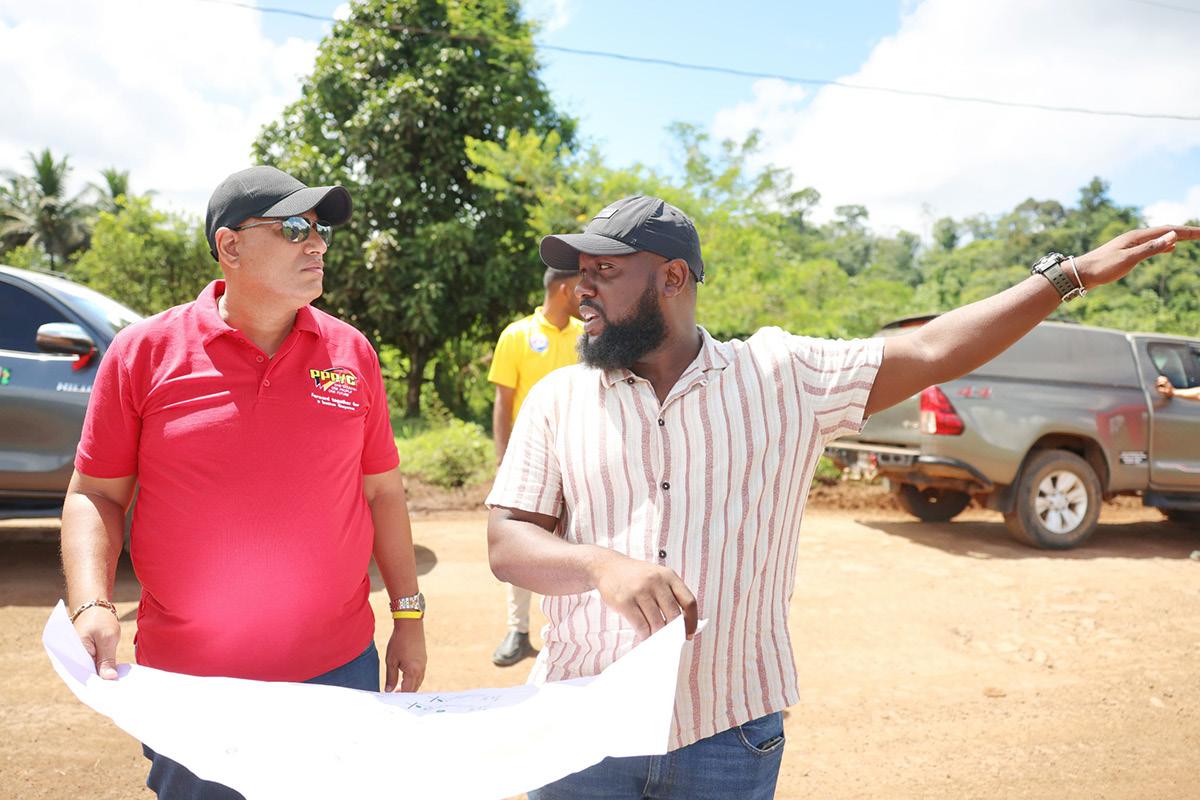
This month, Minister of Housing and Water, Collin Croal, visited the Tract PK site with CH&PA surveyor Shaquille Mayers to evaluate the terrain and initiate preliminary planning for a project that officials anticipate will be a component of the government’s ongoing commitment to enhancing access to affordable and sustainable housing throughout the nation
coastal and interior populations.
During the site inspection, Minister Croal and CH&PA technical teams conducted topographical and cadastral reviews and discussed timelines for surveying, road access, drainage, and water supply assessments — all preliminary steps required before lots can be formally cut and allocated.
The presence of a CH&PA surveyor underlines the ministry’s intent to fast-track technical work so that house-lot rollouts can follow once infrastructure planning is complete.
HOW TRACT PK FITS INTO THE NATIONAL HOUSING STRATEGY
Since 2020, the government has emphasised an ambitious housing agenda: large-scale lot distributions, titling drives, and targeted construction under both coastal and hinterland programmes.
The CH&PA and Ministry of Housing and Water have highlighted multi-region schemes, rapid-build “core homes,” and hinterland housing interventions as key pillars of the strategy.
Tract PK is being positioned as a complementary project that will
link local needs, employment, access to potable water, and durable housing, with the Ministry’s national targets.
Planned housing developments in Port Kaituma are expected to deliver multiple benefits: formalised house lots, access to basic services (roads, drainage, potable water), and opportunities for local construction jobs.
But delivering those benefits in a hinterland setting presents logistical and cost challenges. Officials must ensure that road access, transportation of building materials, and sustainable water solutions are all addressed early to avoid delays and cost overruns, issues the ministry has confronted in other remote projects.
Minister Croal’s handson site inspection signals a focus on mitigating such risks.
GOVERNMENT SIGNALS CONTINUED INVESTMENT
The Tract PK announcement comes amid continued ministry activity across the country, including rapid development at coastal housing schemes and investments to boost water and sanitation infrastructure— both of which are considered essential complements to any housing
rollout. Recent ministry statements and public engagements emphasise that the government intends to sustain housing investments into the next term, with particular attention to completing works, issuing titles, and strengthening the CH&PA’s delivery capacity. Officials say the next steps for Tract PK will include finalized surveys, engineering designs for internal roads and drainage, assessments for potable water and electricity connections, and community consultations to determine lot sizes and prioritisation criteria. Once technical work is complete and funding allocations are confirmed, the CH&PA will move to formally cut lots and begin allocations in line with national housing policies.
While the ministry has provided technical teams for the site visit, the CH&PA’s involvement underscores the importance of technical accuracy in delivering durable housing solutions. Local stakeholders and residents will be invited to public meetings as details are formalized, a step the Ministry has followed in other regions to ensure transparency and community buy-in.

Integrated water strategy drives housing, economic growth in Guyana

THE rapid expansion of housing, commerce, and industry on the Essequibo Islands–West Demerara corridor has received a major boost with the commissioning of a $850 million water treatment plant in Parika.
Designed to process more than 7,000 litres of water daily and deliver 24-hour treated water to over 14,000 residents, the facility is set to play a central role in sustaining the region’s housing boom and improving residents’ quality of life.
Commissioned on August 7, 2025, by President Dr. Mohamed Irfaan Ali, the Parika plant is the fourth large facility completed under the Coastal Water Treatment Infrastructure Programme. It will serve
communities including Parika, Salem, Hubu, Bushy Park, and Hyde Park, complementing housing developments and new lot allocations in the fast-growing East Bank Essequibo corridor.
INFRASTRUCTURE TO MATCH HOUSING EXPANSION
Speaking to hundreds of residents and stakeholders, President Ali underscored the scale of government investment in Region Three’s water infrastructure—over $8.8 billion since 2020, benefitting more than 89,000 residents.
“In water alone, we’ve invested in this region more than $8.8 billion… with new plants in Wales and Parfaite Harmonie, ongoing construction in Wakenaam and Leguan,
and major upgrades at Vergenoegen, Fellowship, and Pouderoyen,” he said.
Ali noted that the housing sector’s rapid expansion has significantly increased water demand. New residential schemes, industrial estates, and agricultural developments are all competing for the same potable water supply— something the government is addressing through an Integrated Water Resource Management (IWRM) strategy.
The IWRM plan aims to: Integrate multiple water sources (including conservancies and other freshwater reserves); Upgrade transmission systems to improve reliability; Build redundancy to prevent service disruptions; and
Differentiate supplies for industrial, agricultural, and household needs.
President Ali stressed that sustaining housing growth requires modern water infrastructure that keeps pace with demand:
“Industrial, agricultural, and household needs are all being met from the same water source. That’s not sustainable. This strategy is about long-term vision—fuelling economic development and ensuring every Guyanese home has access to quality water.”
Ali also signalled upcoming reforms to Guyana Water Incorporated (GWI), aimed at making the utility more “agile and reactive” in meeting the needs of both new and existing
communities.
“We are re-organising GWI to work at a faster pace, because the housing and commercial developments coming onstream require quicker connections and higher service reliability,” he said.
Minister of Housing and Water, Collin Croal, said the Parika plant is part of a broader national target to provide 100% access to treated water along the coast by 2025.
“Today, we turn the tap towards a better quality of life. Children will be able to grow up in a much healthier environment,” Croal told the gathering.
Construction of new treatment plants is underway at Leguan and Vreed-en-Hoop, while facilities at Fellow -
ship, Pouderoyen, and Vergenoegen are being upgraded.
The commissioning of the Parika plant is more than a water-sector milestone—it’s a housing-sector enabler. Reliable, treated water is a prerequisite for: Approving and occupying new housing schemes; Supporting private construction in allocated house-lot areas; and Attracting investment in commercial and industrial hubs linked to residential growth By pairing largescale water infrastructure with aggressive housing development, the government aims to ensure that new communities in Region Three are not only built but will thrive for decades to come.
The plant is expected to support the region’s housing boom and improve inhabitants’ quality of life by processing more than 7,000 litres of water daily and providing 24-hour purified water to over 14,000 residents
Over three decades of excellence: Impressions Branding continues to lead in event innovation
For over 32 years, Impressions Branding has been at the forefront of revolutionising the creative and branding industry in Guyana.
With a legacy that spans over three decades of pioneering event production and branding technology, Shane Sukhlal, Creative Operations Director of Impressions Branding, says the company have firmly established itself as the architects of some of the country’s most prominent and successful events.
Impressions Branding’s roots in event branding can be traced back for about 27 years, with the inception of iconic expos such as Building Expo and GuyExpo. Under his father’s Neal Sukhlal’s visionary leadership, the company has not only delivered largescale, impactful events but has also transformed the way brands engage with the public through innovation and creativity.
“Over the years, we’ve worked with some of the largest companies and have created some of the most extensive branded real estate in the country,” Sukhlal explained.
The company’s event spaces include massive, custom-designed container booths, this year some stretching up to 40 feet by 10 feet , allowing exhibitors a wider platform to showcase their products and capture attendees’ attention in unprecedented ways.
This year, Impres -
sions Branding is proud to introduce a unique feature that highlights sustainability and environmental awareness.
Sukhlal also shared exciting developments in event design and functionality.
prises,” Sukhlal added.
The Building Expo itself stands as a testament to Guyana’s developmental strides, showcasing everything from educational seminars to cutting-edge products from local businesses.
It’s a space where multiple streams of development—from education to private sector

“We now offer modular booths that can be adjusted in size to meet client demands, providing more private spaces for meetings and product launches. These booths are versatile and can be adapted for multiple events throughout Guyana,” he said.
Further elevating the expo experience, this year’s event will feature a dedicated conference facility on-site, providing a professional venue for seminars, workshops, and product launches.
“This facility allows for robust business discussions and knowledge sharing, contributing to the overall growth of the private sector and local enter-
innovation- intersect.
As Sukhlal notes, the company’s use of large, visually impactful displays ensures that every exhibitor’s message is delivered powerfully and memorably, contributing to the overall success of the events and the growth of Guyana’s creative economy.
With his dedication to quality, innovation, and community development Impressions Branding continues to lead toward new heights, enriching Guyana’s event and branding landscape with every project.

Creative Operations Director of Impressions Branding, Shane Sukhlal

